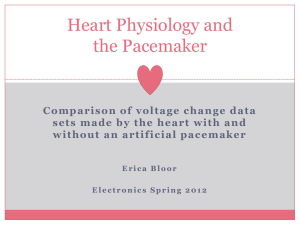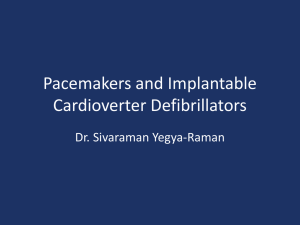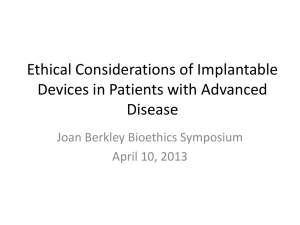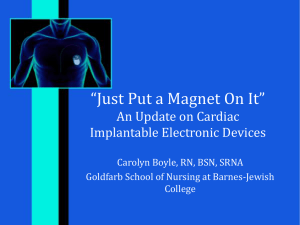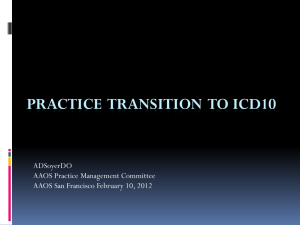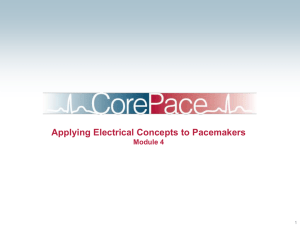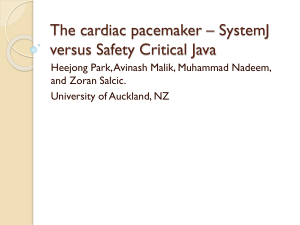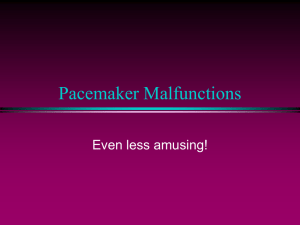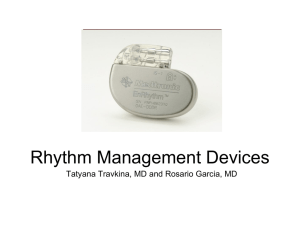What is a pacemaker or Defibrillator
advertisement
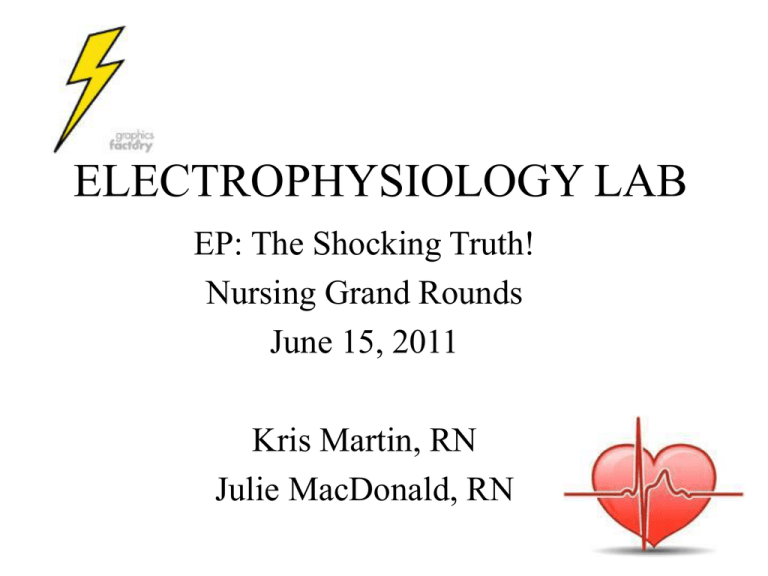
ELECTROPHYSIOLOGY LAB EP: The Shocking Truth! Nursing Grand Rounds June 15, 2011 Kris Martin, RN Julie MacDonald, RN WHERE ARE WE? Wyman Ground in between the OLD ICU and Radiation Oncology What do we do? • • • • • • • • Pacemaker and ICD implants Electrophysiology Studies TEE’s Cardioversions (Electrical and Chemical) Yearly Defibrillator testing Ablations- Atrial flutter and SVT, AVNRT Tilt-Table Testing Pacemaker/ICD Clinic Why an EP study? Diagnoses abnormal heart rhythms and/or induces cardiac arrhythmia's in order to: • Determine the source of arrhythmia symptoms • evaluate the effectiveness of certain medications in controlling the heart rhythm disorder • predict the risk of a future cardiac event, such as Sudden Cardiac Death • assess the need for an implantable device (ICD or pacemaker) or treatment procedure (ablation) copyright Heart Rhythm Society 2004 An Overview of the Procedure • Pt receives conscious sedation and local anesthesia. • Femoral VEIN is accessed-one or both sides. • EP catheters are guided under fluoroscopy to the right atrium and ventricle via the IVC. • Electrodes at catheter tip collect data from various points in the heart (electrical mapping). • Various arrhythmia's can then be induced or ablated, or the decision to implant a pacemaker or ICD can be made. We Maintain a Sterile environment, same as the OR Ablations • Radio frequency energy is delivered through EP catheters to burn a small section of the myocardium. • This prevents the arrhythmia from continuing or returning. • At Mount Auburn, we do SVT and Atrial flutter ablations (Afib and VT ablations are not done here). • EP studies and ablations are typically done as outpatient procedures. These are EP catheters seen on X-ray RA HIS CS R V TEE • Transesophageal echocardiogram • Ultrasound probe passed into esophagus-posterior view of heart. • Diagnoses thrombus, valve disease, septal defects ?source of embolus, bacteremia, or CVA/TIA. • Pre-cardioversion to rule out existing thrombus. • Patients get conscious sedation and generally need to remain NPO for 4 hours after. Cardioversion • Synchronized shock to terminate Afib or flutter. • Pts receive MAC (monitored anesthesia care-propofol) by anesthesiologist • Chemical Cardioversions are when medications are given like Ibutilide or Flecainide and EKG is monitored for conversion and arrhythmia. Defibrillator Testing • DFTs: defibrillator threshold testing. • Usually done on ICD implant and yearly, or if there is a potential device/lead issue. • Frequently outpatient basis. • Patient receives MAC (propofol). • The ICD programer is used to induce VF and looks for the device to deliver a shock. ICD Pacemakers with leads Pre-op Pacemaker/ICD implant • Pt must be NPO after midnight • No applesauce with meds or OJ for low blood sugar! • AM meds are okay with a small sip of water • Meds to hold: heparin, multivitamins, oral hypoglycemics, insulin • Check blood sugar if diabetic • **LEFT sided IV** Post-OP Care of Pacemaker/ ICD • Watch site for S+S infection pt will have prophylactic antibiotic • Watch site for hematoma or bleeding • Moderate amount of bleeding on DSD okay • Bedrest usually for 12 hours post op • Pain: Manual manipulation during implant Percocet or Tylenol Post Op Care • Keep arm in sling overnight, affected arm stays lower than shoulder height, no extended reaching this helps prevent dislodgment of leads! • Next day chest X-ray to confirm lead placement, and device interrogation. • Pt will have a Green/purple folder in chart to take home. Please make sure to give them to patient on discharge • Call MD regarding procedure site, orders, function of pacemaker. Leads... • Thin wires with flexible silicone coating • Connect the pacemaker generator to the myocardium • Sensing of heart activity and discharge of electrical impulse. • Leads are screwed into myocardium. • 6-8 weeks for lead to mature: scar tissue forms around the lead and anchors it. • Extended reaching or lifting during this time may dislodge the lead requiring re-do. Atrial lead Pacemaker leads as seen on Xray(Dual chamber system) Ventricular leads Pacemakers and defibrillators are a complicated business and that is why we have specialists. As a nurse you can not figure out what a pacemaker or ICD is doing by just looking at the monitor. There are a few things that you should know that will help you decide what to do. What is a pacemaker or Defibrillator? • Pacemaker is sensing and monitoring patients own heart rate and delivers an impulse in either the atrium or ventricle in the absence of a sensed beat. • Defibrillator is sensing and monitoring the patients own heart rate for a fast rate usually set 188bpm to deliver a shock to convert to NSR. Can also pace if heart rate is slow usually 40 bpm. What do you need to know? • How many leads does the pacemaker have? 1 lead only sees what is happening in its chamber so a VVI pacemaker only knows what is happening in ventricle. 2 leads sees what is happening in both chambers the atrium and ventricle. Mode DDD/ DDI • What is the lower rate set at? If it is VVI @ 60 it will not pace if heart rate is greater than 60bpm. A Dual chamber pacemaker or DDD will pace in Atrium at lower rate and then that sets up a timing cycle for the Ventricle to either pace or inhibit. In a DDD pacemaker you can see all different types of pacing on EGM strips: A sensed V sensed = A paced V sensed = A sensed V paced = A paced V paced = NSR/ AFIB, pacemaker is inbitited Sinus bradycardia Heart blocks / CHB/2:1 block Heart block/Sinus arrest/asystole Where will you find all this information? You will find it in Meditech under Cardiology Reports tab. If there is no report then they have not been seen at Mount Auburn Hospital Pacemaker Clinic. Ask the patient/family if they have an ID card for their pacemaker. Which will identify the manufacturer. Call pacemaker clinic @ 5622 to evaluate the device. Pacemaker Report Pacemaker Report Clinic Tel: 617/499-5628 _____________________________________________________________________________ Date of Pacemaker check: 03/14/11 Pacemaker Type: Medtronic Sensia Implanted: 09/10/09 Pacemaker programmed rate: 70bpm Mode: DDDR Response with magnet: Asynchronous pacing 3 at 100bpm then 85bpm Presenting Rhythm: AV Paced Underlying Rhythm: HB with PVC Pacemaker Dependent: N Arrhythmia Recorded on Diagnostics: None Battery Life Stable: Y Impedance: A= 410 ohms RV= 531 ohms Sensing: P-wave= 2.8 mv R-wave= 15.6 mv LOC: A= 0.75 @ 0.4 ms RV= 0.75 @ 0.4 ms Comments: In-house s/p fall. Appropriate sensing and capture testing. No arrhythmia's recorded. Unable to promote intrinsic rhythm with AVD at max, no changes made. Reprogramming for testing only. Follow up in six months. When would you apply a magnet to a pacemaker? During electrocautery use in OR or GI Unit. In a pacemaker a magnet causes the pacemaker to Asynchronously pace at a set rate usually 85bpm-100bpm What does this mean? It means that the pacemaker can no longer see what the patients heart is doing and is going to pace at the magnet rate. If the patient is pacemaker dependent or has a HR below 85-100 then you need to apply a magnet. If a magnet is not applied it could result in long pauses or asystole. What if the patient has a Higher HR? If a patient has their own HR then you would not apply a magnet since asynchronous pacing could cause a pacing spike to come in on a T-wave resulting in VT! Remember when you place the magnet on a pacemaker it can no longer see what the patient’s own heart is doing A magnet should be available to place over device if inhibition of pacing occurs resulting in pauses. When do you call pacemaker clinic? This device is over sensing and thinks it sees ventricular activity and inhibits pacing. What you might see on monitor Normal function Non Sensing of R wave Non Capture What do you need to know about an ICD? •You need to know if it is a single (VVI) or dual chamber(DDD) device and the lower rate. • You need to know what the Zones are set at. VT zone or VF zone. • The magnet response will always be: Inhibits therapies, no effect on pacemaker. • If they are pacemaker dependent,they will need to be reprogrammed for surgery to an Asynchronous mode What do you need to know about a ICD? • That it can overdrive pace a patient out of a fast HR if it falls into the VT zone. • That it is not always able to distinguish between AFIB and VT especially if it is a single lead device. A VVI device doesn’t know what the atrium is doing. • You can put a magnet over ICD to disable the therapies and prevent or stop inappropriate shocks. ICD Report ICD Report Clinic Tel: 617/499-5628 ________________________________________________________________________________ Date of ICD check: 05/05/11 ICD Type: Boston Scientific Cognis Implanted: 01/19/11 VT Zone: 185 FVT: VFIB: 220 ICD programmed rate: 60bpm Mode: DDD Response with magnet: Inhibits therapies, no effect on pacemaker Presenting Rhythm: Unknown Underlying Rhythm: Pacemaker Dependent: Arrhythmias Recorded on Diagnostics: none Battery Life Stable: Y Impedance: A= 439 ohms RV= 402 ohms LV= 949 ohms Sensing: P-wave= mv R-wave= 7.0 mv LV-wave= 19.3 mv LOC: A= @ ms RV= @ ms LV= @ ms Comments: Latitude transmission, BiV pacing 92% of the time. Follow up in This is what a magnet looks like some are blue You can find them on all the code carts throughout the hospital, in the OR and GI units. When would you place a magnet over an ICD? If a patient is getting inappropriate shocks. During cautery in OR or GI unit. CMO status until device can be reprogrammed. A Doctors Order is need to apply a Magnet and disable a device. ICD Patients that are Pacemaker Dependent • If they are pacemaker dependent,they will need to be reprogrammed for surgery to an Asynchronous mode. Remember that a Magnet only Inhibits therapies, has no effect on Pacemaker in an ICD Patient. How do you know if they are pacemaker dependent? •Look at the report in Meditech. you will need to call Pacemaker clinic 5622 to arrange for someone to come and evaluate device and reprogram if necessary. In OR, GI unit when cautery is being used the ICD should be disabled by a magnet. Electrocautery can cause noise on the lead, an ICD would interpret it as fast heart rate and deliver an inappropriate shock. The patient should always be on a monitor when the magnet is in place. The benefit of this is that if a VT/ VF episode occurs you can remove the magnet and the device will deliver a shock. If the device was programmed OFF then would need to externally shock the patient. . This is an example of noise on an ICD lead from Cautery. The device thinks this is VF and would deliver a shock if a magnet was not applied. You can always call clinic, 5622 and we will help you figure it out! If a patient has been made CMO you may place a magnet over device until it can be reprogrammed. A note must be in the chart from attending physician that it has been discussed with patient and or family. An order must be written to turn off ICD, before it can be done. If you are applying a magnet an order should be written. This has no bearing on pacemaker portion of ICD and we do NOT turn off pacemakers in CMO patients. When would you apply a magnet to an ICD? •If a patient was receiving shocks that you/MD determine to be inappropriate you may apply a magnet to stop the therapies/shocks. •An example of this would be a patient who is in rapid AFIB with ventricular rate in 190bpm and has a single chamber device with a VT zone set for 188bpm. The ventricular lead only knows that the rate is above 188bpm and that it is programmed to give a shock. Another example of when to place a magnet is the patient is telling you they are getting Shocked and this is the rhythm on monitor/EKG. This is NSR and if the patient is getting shocks from ICD, then you need to disable it with a magnet The lead is most likely broken and over sensing the device will continue to give shocks until it is disabled. What if the device is not giving a shock and you see VT on monitor? The device will only do what it has been programmed to do If a VT Zone is set at 188bpm and a patient is in a VT@a 180bpm the device is never going to give a shock. You would need to externally shock the patient. The pads should be placed to avoid damaging the ICD. What if your patient tells you his device is BEEPING or VIBRATING in their Chest? They are NOT crazy! The devices are set up to alert patients of a problem. You should notify the pacemaker clinic or cardiologist on call. They can call in a company representative to interrogate and find the problem. The beeping and or vibrating will continue every 6-10hours until device is reprogrammed. 8am 2pm 8pm Why is Pacemaker/ ICD follow-up important? We often find new onset AFIB. Device can date and time the event, amount and duration of episodes and give atrial and ventricular rates. We evaluate Histograms to tell us if the heart rate has been fast or if it has been stuck at the lower rate. Medications are often adjusted or Rate Response added. Ventricular Long term Histogram 50 45 40 30 25 Sensed 20 Paced 15 10 Rate (bpm) 180> 180 170 160 150 140 130 120 110 100 90 80 70 60 0 50 5 <40 % of Beats 35 We find broken leads or batteries that need replacement. Non capture or intermittent capture broken lead on x-ray Thrombus/emboli We find non-sustained episodes of VT in pacemaker patients that otherwise would go undetected. This could be causing them dizziness or syncope. New onset Afib is common to find also. In an ICD we can find episodes that received ATP or a shock. After reviewing with the cardiologist, their meds may be adjusted to prevent further therapies. In an ICD we can find episodes of AF getting inappropriate therapies. Medications would be evaluated and adjusted. Atrial vent shock This is another example of inappropriate shock for Sinus Tachycardia and the patient should have medications adjusted to prevent their sinus rate from going this high. THANK YOU FOR COMING The EP Staff QUESTIONS?

